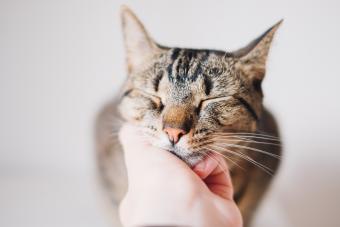
Purring is one of many sounds your kitty uses to communicate, and how cats purr comes down to their unique anatomy. There are all sorts of delicate bones and even fat pads in a cat's throat that make them sound like a Haley Davidson revving. With emerging studies challenging what we thought we knew about this comforting sound, we’ve compiled 11 fun facts about how cats purr that’ll blow your mind and wow your feline-loving friends.
Cat Purring Anatomy
The important parts of the cat's purring anatomy are the vocal cords, laryngeal muscles, diaphragm, and glottis. The glottis is a part of the larynx or voice box and the slit-like opening between the vocal cords. Manipulation of the vocal cords produces the different vocalizations that cats make.
So How Do Cats Purr?
Their anatomy provides the structure for the purring sound you know and love. The alternating action of the laryngeal muscles and the diaphragm produce air movement within the larynx. This causes a build-up of air pressure, and the air is then released through the glottis.
New Discoveries Say Otherwise
A new study is challenging what we once believed about how cats purr. Up until now, researchers thought that cats actively contracted and relaxed their throat muscles in order to purr. But this recent experiment suggests that purring is a “passive phenomenon” — an automatic behavior that doesn’t need any input from the brain.
Basically, this suggests cats don’t consciously purr. It’s just something that happens based on their emotional state and other factors. Interesting, right?
Cats Aren’t the Only Species That Purr
A 2002 study in Mammal Review found that "true purring" is only seen in two scientific families: Viverridae, which include carnivorous critters like the genet, and Felidae, also known as the cat family. But, the exact mechanism behind their purring differs based on the species.
Big Cats That Roar Can't Purr
Not all cats are the same. While your domestic cat can purr, big cats like the lion, leopard, and tiger do not purr, at least not by using the same mechanism as housecats. They can make throaty growls and other sounds, but not a true purr. The only exception is cheetahs, who do purr.
Often, cats are grouped into "roaring cats" and "purring cats" because cats who can purr can't roar, and those that can roar can't purr!
What makes the difference between purring and roaring in domestic cats versus big cats is how their breathing is used to produce the vocalization. Domestic cats purr during inhalation and exhalation. Big cats produce a similar sound, but only when they exhale.
Why We Can Feel Purrs

The repetitive opening and closing of the glottis gives purring its unique sound, but it also allows you to feel the movement within your cat if you place your hand on their side or while holding your cat. The frequency of the glottis movement is about ten times that of normal respiration, according to Dennis Turner in his book The Domestic Cat: The Biology of Its Behaviour.
Purring Might Be Trigged by the Nervous System
A 1972 study in Respiration Physiology explains that the act of purring may be triggered by the central nervous system, which triggers a nervous reaction and causes the glottis to oscillate. The central nervous system consists of the brain and spinal cord. These findings provide further evidence that purring may be some instinctive form of communication.
Cats Purr for Many Reasons
You've probably noticed that your cat purrs when they're content or relaxed. But they can also purr when sick or in pain. These are just a few of the many reasons why cats purr. Turner explains that a cat may purr to signal appeasement to its human owner.
Purrs Might Be Healing
Further evidence that supports purring as a survival function comes from a 2006 report in Scientific American. The frequency of a cat’s purr falls between 25 and 150 Hertz, and data shows that low-frequency vibrations from 25 to 50 Hertz can promote bone growth and even repair bone.
This suggests that purring might help improve your cat's health and even increase their bone density. That's why if your cat is purring in a stressful situation, such as a visit to the vet, they might be relying on their own biology and physiology to heal them.
Cats are certainly self-cleaning machines, but the idea that they could also have self-soothing and self-healing properties is pretty incredible.
They Could Even Heal You
Along with healing themselves, a cat’s purr has demonstrated some pretty healing abilities for their humans. It can lower your blood pressure, minimize stress, and even reduce your risk of cardiovascular disease. Even though your cat crawling into your lap and purring away while you’re on a Zoom call might be annoying, just think about it like this: maybe they’re trying to heal you.
Purring for Attention
On the other hand, cats have been known to purr louder with the sole intention of catching your attention. Sneaky little things. According to the University of Sussex, cats may interject an embedded, high-pitched cry, not unlike the sound of a baby crying. This action occurs through manipulating the glottis and vocal cords.
Scientists refer to this type of purring as solicitation purring. If you have ever been woken up by your cat before the alarm has gone off, you may have experienced solicitation purring first hand. How could you ignore your cat purring beside your head as you try to continue to sleep? Scientists suggest that the sound of this purring solicits an instinctive reaction in humans to respond to a crying baby.
Fun Facts About How Cats Purr
How do cats purr? The answer lies in a cat's biology and physiology. Purring is another example of the instinctive behavior of cats to communicate and get what they want. But who can resist those big round eyes, cute ears, and buzzing purr?







